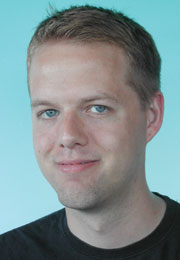Dr. Anders Johansen
The PhysOrg article Dirty stars make good solar system hosts said
“Some stars are lonely behemoths, with no surrounding planets or asteroids, while others sport a skirt of attendant planetary bodies. New research published this week in The Astrophysical Journal Letters explains why the composition of the stars often indicates whether their light shines into deep space, or whether a small fraction shines onto orbiting planets.When a star forms, collapsing from a dense cloud into a luminous ball, it and the disk of dust and gas orbiting it reflect the composition of that original cloud and the elements within it. While some clouds are poor in heavier elements, many have a wealth of these elements. These are the dirty stars that are good solar system hosts.
The new simulations by Mac Low and his colleagues Anders Johansen (Leiden Observatory in the Netherlands) and Andrew Youdin (Canadian Institute of Theoretical Astrophysics at the University of Toronto) compute just how planets and other bodies form as pebbles clump into mini-planets referred to as planetesimals. Their current work hinges on their previously published research (in Nature in 2007) that explains why rocks orbiting a star within the more slowly-revolving gas disk are not quickly dragged into the star itself because of the headwinds they feel.”
Anders Johansen, Ph.D. is Postdoctoral fellow at Leiden University, Leiden, The Netherlands. He is winner of the 2007 Otto Hahn Medal of the Max Planck Society, and of the 2005 Patzer Prize and 2007 Patzer Prize.
His scientific interests include: planet formation and protoplanetary discs, exoplanets, magnetized accretion discs, turbulence, dust dynamics and turbulent diffusion, self-gravity and particle-mesh methods, and supercomputing and parallel programming.
Anders coauthored Prograde rotation of protoplanets by accretion of pebbles in a gaseous environment, Particle Clumping and Planetesimal Formation Depend Strongly on Metallicity, Zonal Flows and Long-Lived Axisymmetric Pressure Bumps in Magnetorotational Turbulence, Planet formation bursts at the borders of the dead zone in 2D numerical simulations of circumstellar disks, Standing on the shoulders of giants: Trojan Earths and vortex trapping in low mass self-gravitating protoplanetary disks of gas and solids, and Embryos grown in the dead zone: Assembling the first protoplanetary cores in low mass self-gravitating circumstellar disks of gas and solids. Read the full list of his publications and view movies of his computer simulations.
Anders earned his BSc in Physics and Astronomy at Copenhagen University in 2002 with the thesis Detections of planetary transits with the GAIA satellite. He earned his MSc in Astronomy at Copenhagen University in 2004 with the thesis Ice condensation, dust coagulation, and vortex activity in protoplanetary discs. He earned his Ph.D. at Max-Planck-Institut für Astronomie in Heidelberg in 2007 with the thesis Numerical models of the early stages of planet formation.
